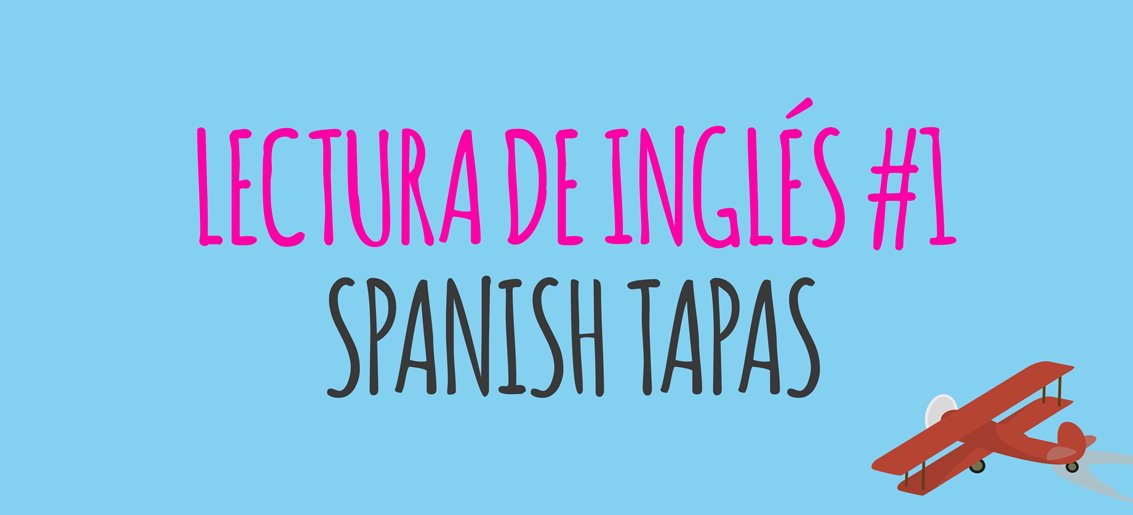1# Let’s talk in english!: Spanish tapas
Hoy comenzamos con esta primera entrega de Lecturas en Inglés, ¡en concreto vamos a comenzar por las Spanish Tapas para ir abriendo el apetito!
Hello everyone!
Have you ever wondered why tapas are so famous in Spain? If you are curious to learn more about this particular subject keep reading!
Tapas are a big part of Spanish culture, the term refers to small plates of food that are usually accompanied by a drink.
History can´t really tell us where this tradition started, so I will let you know about the most common theories and I will let you pick the one you like the most.
The most popular theory claims that Alfonso X, byname Alfonso the wise (13th Century), is who originally introduced this concept in Spain, he was told by his doctors to drink a few glasses of wine a day (Yay for Spanish doctors!) so he started having a few bites with them to avoid the alcohol effects.
The second theory talks about how the Catholic Monarchs (Reyes Católicos), Isabel and Fernando (15th Century), seeing that fights were the norm outside taverns, ordered for every tavern to serve small portions of ham or cheese with every alcoholic drink to prevent the fighting.
Moving in time to the 20th Century but not away from the monarchy, our third theory takes us to Alfonso XIII when, on a visit to southern Spain, made a stop in El Ventorrillo del Chato in Cadiz to have a drink. A sand storm made the bartender use a slice of ham to cover the wine glass as if it was a lid (tapa in Spanish), the king liked it so much he ordered a second drink with one of those “tapas”.
Regardless of when or where tapas started, we´ll have to agree that they are a fundamental part of the current Spanish culture, travelling to different countries and offering a wide range of varieties, from the classics to the new modern ones.
Different tapas for different moments
Tapas can vary from a plate of olives or crisps, to a small plate of Russian salad or paella, to more sophisticated and elaborated plates, and this will be determined by the moment and the place.
The most simple tapas are usually offered for free in every bar when ordering a cold drink, so don´t be scared when the bartender brings a plate of anchovies, cold meats, potato salad, olives, crisps… when ordering your beer, relax and enjoy, you are in Spain and this little pleasures are on the house.
If you are looking for something more satisfying, you can go out looking for tapas, this are bigger plates that can be ordered from the menu, usually at low prices. Anything you can think of can be turned into a tapa, and depending on the area and bar this might vary.
I should mention that depending on what area of Spain you are visiting, the tapas culture will be different. For instance, if you are in southern Spain, tapas bars will have a wider offer, you´ll be able to choose from a list of cold meats, fish, meat, sandwiches… the possibilities are endless. Some bars will specialize in small sandwiches, called montaditos or pulgas, others will specialize in fried fish (Frituras) and others will have all sorts of different tapas to choose from.
In northern Spain it is more common for bars to have a few specialities, so you´d have one tapa at each bar rather than sit in, as you´d do in other cities. Tapas bars are usually situated in the same area or street, so it is very common for Spanish friends and families to go out to these areas and walk from bar to bar, having some drinks and tapas.
It is also very important to choose the moment when going out for tapas, we could differentiate three different moments: Vermut, lunch & dinner.
Vermut is the magical hour between 12:00 to 15:00 when it might be early to have proper lunch, but it is not too early to start having a wine or two. Spanish friends meet outside of the house to grab a few wines or beers and accompany this with some light tapas before going home for lunch. The danger of doing Vermut is turning it in a “Vermut torero”, expression referring to the vermut turned into an improvised lunch, or a later vermut. You can purposely do a Vermut torero, meeting your friends for a quick tapas lunch, or this can be accidental, when meeting friends for a few drinks before lunch, and then realizing it is already 17:00 and you already had too many drinks and tapas.
Some shocking facts related to tapas
– Tapas are a social way of life, forget about individual food plates, tapas will be brought to your table in a common plate and are shared by everyone. You might get lucky and get your own fork, but depending on the tapa you´ll most likely just use your fingers, bread or a toothpick to eat your food. This is quite surprising to foreigners arriving in Spain for the first time, but sharing is the true nature of tapas.
– Don´t run away from bars with a million paper napkins on the floor, this are the best ones! Spaniards throw their dirty napkins next to the bar´s table, and this is swept at the end of the day, so the more napkins, the more people eating their tapas, it is a quicker and easier way to check costumer reviews than tripadvisor. I know this might seem like bars or Spanish are dirty, but it is just common practice, and it is quite normal for us. I have to mention that this doesn´t affect the quality of the food served and it doesn´t reflect the cleanliness of the kitchen, as bars and restaurants go over numerous and frequent health inspections, and Spanish food is well-known for the good quality and freshness of it´s products.
– When it comes to paying for tapas, how do Spanish take care of the bill? The answer will be different depending on whether you had your tapas in one bar or in different ones, if you had all your food and drinks in the same bar, this is quite simple, you´ll split the bill between everyone at the table. This is called “pagar a escote”, you divide the bill between the number of people sitting at the table, regardless of what they had, odds are everyone had the same to eat, as tapas are shared, some might have had a few more drinks, but when paying “a escote” this is not taken into account. If you plan on going to different bars for your wines and food, there are some different options depending on who you are with, this are my favourites:
- “Poner bote”: If you decide you are going to use this method, everyone will give their share to the designated person in charge of the “bote” (money from everyone who will be eating) before going to the first place, for the rest of the day the person in charge will order and pay for everyone´s drinks and tapas at each bar. You´ll need to agree on how much money you´ll want to spend on that day, and everyone gives in the same amount (parents pay for their kids, and usually pay less for them as they don´t spend as much). When the bote runs out, you decide if you want to add some more or if you are already full, if you all decide you are finished before running out of bote, you can decide to keep it for the next day, or to spend it on coffee or dessert.
- Rondas (rounds): If you are doing rounds, each one of you will pay at a different bar. The amounts paid are different, as not all tapas have the same price, but no one will be worrying about this, this practice is common among friends and family who see each other often, and the amounts paid will compensate over time.
Drinks that get along with tapas
Even though you can have any drink you want with your tapas, there are some that are traditionally associated with them, this are wine, beer, mosto and vermut.
We´ve talked about going out for vermut earlier, but we need to mention that this term comes from the drink Vermut, typically consumed during that time of the day, made with wine and herbs.
If you are going to go for more than a couple, you might want to order the small version of this drinks, this can be ordered by asking for a chato (a smaller glass of wine), a corto or a zurito (a smaller glass of beer) or a marianito (a smaller glass of vermut). This terms come from La Rioja and the Vasc Country, in northern Spain, but are commonly used in the whole length of Spain nowadays.
You can also order a clara, and you´ll get your beer with lemonade or spring water, or a tinto de verano, being this red wine with lemonade, spring water or orange soda.
Mosto is a non-alcoholic drink made with grapes, very sweet as it has a high content of sugar, kids will typically order this when doing tapas with their families.
So, why not try tapas yourself now that you know all about them? Enjoy them with friends, family, with a glass of wine of a soft drink, have them for lunch, forget about the clock and experience what a true vermut torero is, and let us know what you think!
Have a wonderful day,













What a great piece of writing about Spanish tapas! I am definitely using this text in my next reading comprehension lesson. Thanks for sharing it with us.
Excellent story… this is an interesting way to know about other cultures.
Thank you !!